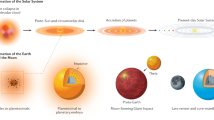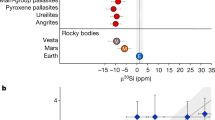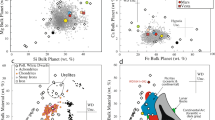Abstract
ONE feature of Prof. H. C. Urey's new theory1 of the development of the planets is that it leads him to conclude on several grounds that the earth's central core has an iron composition. This conclusion is in conflict with Ramsey's proposal2 that the density throughout the earth's deep interior, at least below a depth of 1,000 km., is essentially determined by pressure right through to the earth's centre rather than by change of chemical composition. The conclusion as stated is also in conflict, though to a less degree, with my proposals, which differ from Ramsey's through finding a balance of evidence3 in favour of a separate chemical composition, such as nickel–iron with possibly some denser material, for the earth's inner core, but agree with Ramsey's in postulating a modified ultrabasic rock composition for the outer part of the core, that is, between depths of 2,900 km. and 4,980 km.—the region that I have referred to4 as ‘E’; the latter postulate will be referred to as α. On the further hypothesis, β say, that the terrestrial planets have a common primitive composition, Ramsey's theory implies that neither Venus, Mars nor Mercury has an inner core, whereas my work favours the view that all three have inner cores.
This is a preview of subscription content, access via your institution
Access options
Subscribe to this journal
Receive 51 print issues and online access
$199.00 per year
only $3.90 per issue
Buy this article
- Purchase on Springer Link
- Instant access to full article PDF
Prices may be subject to local taxes which are calculated during checkout
Similar content being viewed by others
References
Urey, H. C., Geochimica et Cosmochimica Acta, 1, 209 (1951); “The Planets, their Origin and Development” (Yale Univ. Press, 1952).
Ramsey, W. H., Mon. Not. Roy. Ast. Soc., 108, 406 (1948).
Bullen, K. E., Mon. Not. Roy. Ast. Soc.: (a) 109, 457 (1949); (b) 109, 688 (1949); (c) 110, 256 (1950).
Bullen, K. E., “Theory of Seismology” (Camb. Univ. Press, 1947).
Elsasser, W. M., Science, 113, 105 (1951).
Feynman, R. P., Metropolis, N., and Teller, E., Phys. Rev., 75, 1561 (1949).
Jeffreys, H., Mon. Not. Roy. Ast. Soc., Geophys. Supp., 4, 62 (1937). 355 (1949); 6, 50 (1950).
Bullen, K. E., Mon. Not. Roy. Ast. Soc., Geophys. Supp., 5, 355 (1949); 6, 50 (1950).
Bullen, K. E., Nature, 157, 405 (1946).
Rabe, E., Ast. J., 55, 112 (1950).
Jeffreys, H., Nature, 169, 260 (1952).
Author information
Authors and Affiliations
Rights and permissions
About this article
Cite this article
BULLEN, K. Cores of Terrestrial Planets. Nature 170, 363–364 (1952). https://doi.org/10.1038/170363a0
Issue Date:
DOI: https://doi.org/10.1038/170363a0
This article is cited by
-
The X-Ray Spectrometer on the MESSENGER Spacecraft
Space Science Reviews (2007)
-
Solar System Processes Underlying Planetary Formation, Geodynamics, and the Georeactor
Earth, Moon, and Planets (2006)
-
Surface-Exosphere-Magnetosphere System Of Mercury
Space Science Reviews (2005)
-
Cores of the Terrestrial Planets
Nature (1973)
-
On planetary cores
The Moon (1973)
Comments
By submitting a comment you agree to abide by our Terms and Community Guidelines. If you find something abusive or that does not comply with our terms or guidelines please flag it as inappropriate.



